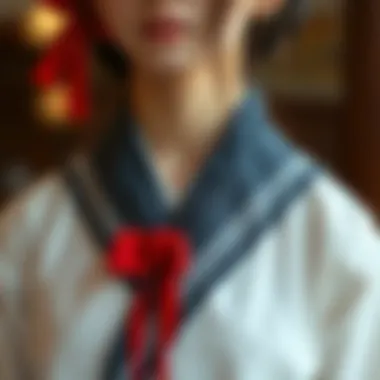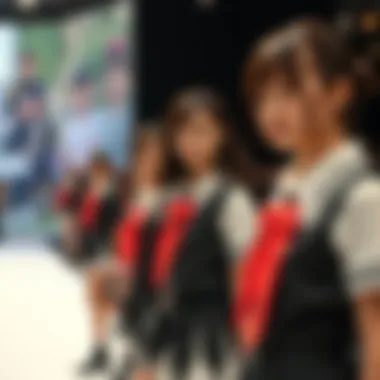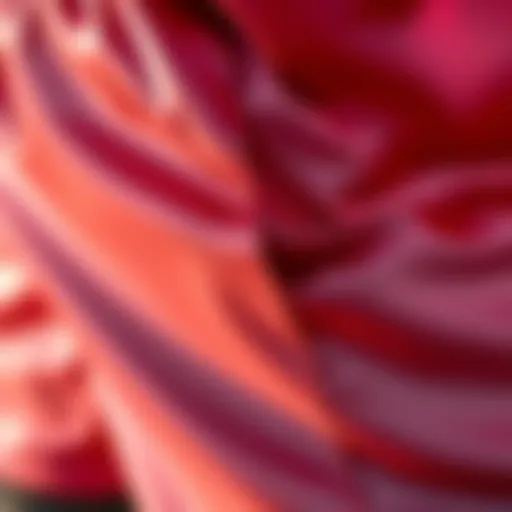The Cultural Impact of Japanese Schoolgirl Uniforms


Intro
Japanese schoolgirl uniforms, known as seifuku in Japan, have become symbolic not only of education but also of youth culture and identity. From their humble beginnings in the late 19th century, these uniforms have undergone significant transformation, adapting to societal changes and influencing modern fashion.
Historically, schoolgirl uniforms were introduced to symbolize Western-style education in Japan, largely influenced by the country's modernization efforts. They serve not just as a means of identification within educational institutions but also as a canvas reflecting broader cultural narratives.
In contemporary society, these outfits have evolved, emerging in various subcultures and global fashion trends. They resonate with themes of femininity, strength, and rebellion—each interpretation layered with complexity. As we explore various facets of these garments, we'll delve into their craftsmanship, significance in popular culture, and the impact of globalization, aiming to paint a comprehensive picture of their role within and beyond Japanese borders.
Historical Context
The historical trajectory of Japanese schoolgirl uniforms serves as a window into the social, cultural, and political evolution of Japan. Understanding this context helps to illuminate not only the aesthetic choices made in uniform design but also the underlying values reflected in these choices. This section sets the stage for exploring how uniforms have transcended mere clothing to embody intricate narratives related to identity, discipline, and reform in educational settings.
The Emergence of School Uniforms in Japan
The advent of school uniforms in Japan can be traced back to the late 19th century, a time when the country was undergoing significant transformations. In 1871, the Meiji government initiated reforms aimed at westernizing various aspects of Japanese life. School uniforms followed suit, emerging first in elite schools as a means to establish a sense of equality among students from different social classes.
In those early days, uniforms were not universally worn. Instead, they functioned as symbols of prestige and modernity. The introduction of uniforms aligned with Japan's broader educational reforms aimed at fostering a sense of national identity and discipline among the youth. A notable aspect of this development was not only the adoption of uniforms but the establishment of a unique Japanese identity that still remained grounded in tradition.
As uniforms became more commonplace, schoolgirl attire began to take on distinct styles—shifting from Western influences to designs now recognized as fundamentally Japanese. Characteristics like pleated skirts and tailored blazers gradually emerged, reflecting a balance between adopting western aesthetics and paying homage to traditions.
Influence of Western Styles in Early Adoption
The influence of Western styles on the early adoption of Japanese schoolgirl uniforms is significant. When Japan reopened to the world during the Meiji period, a wave of Western fashion streamed into the country, prompting a radical change in clothing culture. The distinct blazers and skirts seen today have roots in European designs, showing how globalization can lead to local adaptations.
For instance, the sailor suit, which became a staple of female school uniforms, draws from naval attire, a nod to the maritime traditions of many countries. The adoption of such styles didn’t happen in a vacuum; it was indicative of Japan's broader aspirations to modernize and compete on a global stage.
Insights into the juxtaposition between traditional Japanese design and Western influence reveal much about societal values and the pursuit of modernity in educational environments. This nuanced interplay has crafted a uniquely Japanese identity—one that retains its essence while evolving dynamically within a global context.
In summary, understanding the historical context of Japanese schoolgirl uniforms—where they came from and how they’ve transformed over time—provides a solid foundation for exploring their cultural significance today.
Design Elements
The design elements of Japanese schoolgirl uniforms are not merely a matter of aesthetics; they embody a rich tapestry of cultural significance, functional necessity, and social identity. As we explore these components, it becomes clear that each aspect—from the uniforms’ typical styles to the materials used—plays a crucial role in shaping perceptions and experiences within educational settings.
Typical Components of Japanese Schoolgirl Uniforms
Blazers and Skirts
When one thinks of Japanese schoolgirl uniforms, the image of tailored blazers and pleated skirts often comes to mind. These two elements work in tandem, merging formality with youthful flair. The blazer, often adorned with school insignia, serves as a symbol of belonging and unity. It instills a sense of discipline among students, reinforcing the idea that they are representatives of their school.
On the other hand, skirts—typically knee-length—offer a practical and comfortable option, allowing for ease of movement throughout the school day. The combination results in a uniform that is not only recognizable but also functional, making it a popular choice among both students and educators. However, there are challenges associated with these garments. For example, preferences vary widely, as some students may find the traditional skirt restricting, prompting discussions on individuality versus uniformity.
Sailor Suits
Sailor suits have carved a special niche in the realm of schoolgirl uniforms, often considered more whimsical yet deeply rooted in tradition. Originating from naval attire, the sailor suit's characteristic collar and tie evoke feelings of nostalgia. This design resonates with a sense of camaraderie and exploration, insinuating a journey through education.
Moreover, the sailor suit is celebrated for its adaptability. It lends itself well to modifications, be they in color or emblem placement, allowing schools to infuse their identity while keeping the essence intact. However, there is a discussion around body image associated with this style. Some students feel pressured to conform to certain body types that these suits are often portrayed in, which can hinder self-esteem and individual expression.
Accessories
Accessories play a vital role in amplifying the cultural significance of the uniform. Items such as ribbons, socks, and bags can provide a touch of personal flair, signaling one's personality amid the collective identity that the school uniform promotes. Ribbons, often worn around the collar, not only adhere to the aesthetic but can also become a point of pride and individual expression.


Moreover, accessories like knee-high socks or specific types of shoes are not just fashion statements; they can also contribute to comfort and functionality. However, the fine line between self-expression and adhering to school dress codes raises questions about the balance between individuality and conformity within the educational milieu.
Material Choices: Fabric and Functionality
The choice of materials used in crafting these uniforms is paramount to their overall functionality and appeal. Traditional fabrics like wool and polyester are common, balancing durability with comfort. Wool is often chosen for its warmth and longevity, while polyester helps in easy maintenance and adaptability to various weather conditions.
Furthermore, as sustainability gains traction globally, many schools are exploring eco-friendly materials to minimize their environmental footprint. Yet, the process involves navigating cost implications and accessibility, which can be challenging for some institutions. The conversation around fabric and functionality is not solely about comfort; it reflects broader societal values regarding sustainability and responsible consumption.
"Uniforms are not just dress codes; they are symbols of community, identity, and evolving norms within education."
Cultural Implications
Cultural implications surrounding Japanese schoolgirl uniforms are profound, revealing layers of social norms, historical contexts, and pressing contemporary issues. Analyzing these implications offers insight into the fabric of Japanese society, where conformity and individuality often dance in a delicate balance. The significance of uniforms extends well beyond mere clothing; they represent discipline, tradition, and the ongoing conversation around gender identity and fashion expression.
Uniforms as a Symbol of Discipline and Tradition
In Japan, school uniforms embody a legacy of discipline and traditional values. From the outset of schooling, uniforms serve as tools for instilling a sense of order and responsibility in students. In many ways, these garments are not just about style; they’re about creating a uniform standard that fosters equality among students.
The tradition of uniforms is deeply embedded within the educational system. They act as visual markers of status, or a lack thereof, encouraging a sense of unity. Students, adorned in matching outfits, step into classrooms as individuals yet share a collective identity. It’s this duality that showcases the ethos of the Japanese educational structure—cooperation and discipline paired tightly together. The colors, styles, and symbols resonate with both history and modernity, allowing students to wear something that ties them back to national pride and cultural heritage.
Moreover, the adoption of uniforms often leads to discussions about discipline. It’s believed that wearing a set uniform cultivates habits of punctuality, neatness, and respect for institutional frameworks. Over time, these elements morph into societal norms, emphasizing the importance of adhering to established codes of conduct. In essence, donning the schoolgirl uniform becomes a rite of passage, signifying entry into adulthood, where the ideals of discipline and tradition are cherished.
Gender Identity and Expression in Fashion
Japanese schoolgirl uniforms also sit at the nexus of gender identity and fashion, allowing for an exploration of how attire can influence self-expression. Traditionally, these uniforms have been criticized for their overtly feminine angles, often reinforcing gender stereotypes. However, as societal norms evolve, so does the interpretation of these garments.
Today, as younger generations navigate the complexities of gender identity, the schoolgirl uniform transforms into a canvas of expression. While the imagery might project erudition and conformity, the reality is quite different. Students often personalize their uniforms with accessories or unique hairstyles that reflect their individuality, making a statement about who they are beyond the uniform itself.
The debate surrounding gender expression in relation to school uniforms raises important considerations regarding inclusivity. The evolving interpretation of what it means to identify as male, female, or non-binary within these uniform policies brings to light the need for revision and reform. Schools are slowly beginning to recognize that incorporating flexibility within their uniform codes can foster an inclusive environment, where students feel empowered to express their identity.
"The uniform becomes an extension of one's identity, where tradition meets the desires for personal expression—creating a modern reinterpretation of fashion itself."
Through this lens, we see that schoolgirl uniforms embody not just a cultural artifact but a living testament to how clothing can intersect with broader societal changes, creating dialogue around gender identity and allowing space for many expressions within a homogeneous framework.
The discourse around the cultural implications of these uniforms highlights the interplay between discipline and expression, urging a deeper understanding of how clothing can reflect societal values and individual narratives.
Educational Environments
Impact of Uniform Policies on Student Life
Uniform policies are more than mere rules set by educational institutions. They create a unique atmosphere in which students navigate their daily lives. For example, the standardization of dress can alleviate competition and economic disparities among students. You won’t hear whisperings about who wore the latest fashion or whose shoes were pricier. This sense of equality often allows students to focus on what truly matters – education and personal development.
"Uniforms level the playing field, making differences in economic backgrounds less visible."
Take, for instance, the case of a student named Yuki. In her school, wearing the designated sailor-style uniform meant she stood shoulder to shoulder with peers from various backgrounds, where designer labels and high-street fashion didn’t matter. This removal of material barriers can ease tensions and conflicts, making hallways more conducive to learning and fellowship.
Of course, this is not to say that uniforms are faultless. There are discussions regarding the individuality stifled by such policies. Students might feel pressured to conform, leading to feelings of frustration trying to express themselves within strict boundaries. The relationship between identity and educational policies warrants consideration.
The Role of Uniforms in Fostering Community
Uniforms also serve as a thread that weaves familiarity and community among students. When they don their uniforms each morning, students don’t just dress alike; they foster a sense of belonging. A simple blazer and skirt combination becomes a badge of camaraderie, reinforcing shared experiences and collective goals.
In Japanese schools where uniforms are deeply ingrained, events like school festivals see students unite and celebrate their identities as members of a single institution. Everyone dressed uniformly evokes a prideful spirit among students. This can be crucial in a student’s journey, as feeling part of a community can both boost confidence and provide support.


In addition, this sense of belonging extends to traditions like graduation ceremonies. Graduates adorned in their distinctive uniforms signify a shared journey of education and growth, punctuated with a traditional flair that resonates with personal sentiments for many. The uniform becomes a vessel for reminiscence, marking the transition phases in a student's life.
In summary, the educational environments shaped by uniform policies carry profound implications for student life. They establish a foundation of egalitarianism while also nurturing a spirit of community. As we observe this dynamic interplay, one can appreciate how these uniforms extend beyond mere clothing, embodying the intricate tapestry of experiences that define Japanese educational culture.
Global Influence
Japanese Aesthetic Reaching International Shores
Japanese schoolgirl uniforms have transcended their initial role in education to become fashion staples in various parts of the world. It’s not just about the fabric and cut; rather, it encompasses an entire cultural aesthetic, synonymous with youth and vibrancy. In cities like Seoul, Paris, and New York, elements of the Japanese uniform have been assimilated into street fashion and high-end design, revealing a nuanced admiration for Japanese culture.
- The iconic sailor suit, with its playful yet sophisticated design, has found its way into the collections of numerous global fashion designers, who reinterpret this classic silhouette through their lenses.
- Japanese pop culture, especially in anime and manga, has further propelled this trend, leading to a fascination with the schoolgirl archetype that resonates with a broad range of audiences worldwide.
Moreover, fashion brands and stylists are increasingly incorporating Japanese aesthetics into their offerings, thereby enriching the global sartorial landscape. The visuals from these uniforms often appear on social media platforms, turbocharging their appeal and leading to a collective fashion dialogue that transcends cultural boundaries.
The Commodification of Schoolgirl Uniforms
As the allure of Japanese schoolgirl uniforms grows, we see a shift toward their commodification—a process where something originally imbued with cultural significance becomes a commercial product. This phenomenon raises various considerations regarding authenticity and representation.
- On one side, the commodification fosters an appreciation for Japanese culture, inviting consumers to engage with it in a personal way. Popular brands have crafted versions of schoolgirl uniforms that draw inspiration from the originals, often remixing them into contemporary styles—think oversized blazers paired with street-smart accessories.
- However, this commercial twist also brings about ethical concerns. With demand escalating, concerns arise regarding labor practices and sustainability in production. Questions linger: Are these garments being made ethically? Are the laborers receiving fair compensation?
The balance between cultural appreciation and commodification is delicate. As consumers, understanding the origins and implications of these uniforms can lead to more responsible fashion choices. Hence, recognizing schoolgirl uniforms not just as garments but as cultural artifacts can enhance the meaningful engagement with the styles adopted globally.
"Cultural exchange is like a dance; if one step goes wrong, the entire performance can falter."
Navigating this terrain requires a commitment to respecting the roots of these designs while also appreciating their place in the global marketplace. The trends set by these uniforms are multifaceted, encouraging dialogue about culture, identity, and consumerism that resonates with stylists, designers, marketers, and scholars alike.
Trends in Modern Fashion
Understanding the trends in modern fashion surrounding Japanese schoolgirl uniforms opens a window to how cultural symbols are continually reshaped. As the global landscape of fashion evolves, these uniforms don’t just remain icons of Japanese culture—they traverse borders and adapt into various contemporary styles. This section will unravel the significance of these trends, looking at how cultural symbolism translates into fashion adaptability, along with the implications for identity and fashion consumption.
Contemporary Adaptations of the Schoolgirl Uniform
In recent years, the schoolgirl uniform has been reimagined through numerous lenses, making it a staple in urban fashion scenes worldwide. Interestingly, many designers find themselves drawing inspiration from Japanese aesthetics, creating unique pieces that uplift the classic designs while incorporating contemporary elements. For example, brands like Comme des Garçons have embraced the iconic sailor collar through avant-garde reinterpretations, adding layers, textures, and unexpected silhouettes.
Moreover, retail giants have noticed the commercial viability of these adaptations. Casual wear brands, like Uniqlo, have produced lines featuring uniform-inspired components, reflecting both functionality and style. These adaptations maintain the spirit of the original uniforms while catering to modern sensibilities.
The importance of these adaptations can't be understated. They portray a melding of cultures, where traditional attire is not confined to its geographical roots but is skillfully integrated into the wardrobes of diverse populations. The global fanbase eager for these styles is a testament to their lasting appeal.
Influence of Pop Culture and Media
Pop culture has played a profound role in the enduring appeal of Japanese schoolgirl uniforms, spreading their influence far beyond Japan's borders. From anime series like Sailor Moon, which romanticizes the uniform's charm, to films and fashion editorials, these outfits have become synonymous with youthful rebellion and idealized femininity. The portrayal in various media has not only enhanced the aesthetic appeal of these uniforms but has also fostered a cultural phenomenon that champions creativity.
- Anime and Manga: Titles featuring school settings often celebrate the uniforms, presenting them as symbols of innocence and youthful aspiration. This strong connection veers into themes of friendship, growth, and identity, allowing audiences to identify with characters donning these uniforms.
- Fashion Influencers and Icons: Fashion influencers across social media platforms rock filtered versions of schoolgirl attire, blending layers and fun accessories to create their interpretations. This not only showcases versatility but also invites ongoing dialogue surrounding gender norms and self-expression.
"Fashion is important because it reflects our identity and gives voice to cultural narratives that shape us. The schoolgirl uniform is a potent symbol within that dialogue."
Through these means, the aesthetic of the schoolgirl uniform etches itself into global consciousness, dynamically adapting while remaining rooted in its original context. This intersection of pop culture and fashion not only elevates the uniform's status but also stimulates discussions around femininity, youth culture, and individual expression—elements that continue to resonate in contemporary society.
Sustainable Practices in Production
The conversation surrounding the cultural significance of Japanese schoolgirl uniforms extends beyond their aesthetic and societal roles. A growing concern among educators, fashion designers, and students alike is the impact of these garments on our environment. This section explores sustainable practices in production, emphasizing their benefits and considerations, as society moves toward greener alternatives in fashion.


The Push for Eco-Friendly Materials
In recent years, the textile industry has witnessed a shift towards the use of eco-friendly materials. Traditional uniforms often utilize synthetic fabrics, which are notably durable but harmful to the environment. The push for eco-friendly options involves embracing materials such as organic cotton, Tencel, and recycled polyester. Such fabrics not only reduce environmental footprint but also offer breathability and comfort, essential for students.
- Organic Cotton: Unlike conventional cotton, which requires considerable pesticides, organic cotton is cultivated without harmful chemicals, fostering healthier farming practices.
- Tencel: This fiber, derived from wood pulp, not only biodegrades easily but is produced in a closed-loop system that minimizes waste and emissions.
- Recycled Polyester: This innovative fabric repurposes plastic bottles and other materials, giving a new life to waste and reducing the dependency on virgin petroleum.
The adoption of these fabrics contributes to a circular fashion philosophy, encouraging consumers to think about the lifecycle of their clothing. This shift doesn't merely benefit the environment; it can also enhance the appeal of schoolgirl uniforms, providing a modern twist that resonates with eco-conscious students.
Ethics in Fashion: A Growing Concern
The conversation around Japanese schoolgirl uniforms cannot be devoid of ethical considerations. In recent years, as the global community becomes increasingly aware of ethical fashion, stakeholders in the industry are scrutinizing production methods to ensure that they align with humane practices.
When delving into the ethics of schoolgirl uniforms, several critical issues arise:
- Labor Conditions: Sourcing materials ethically means supporting factories where workers are paid fair wages and work in safe conditions. The push for transparency in the supply chain is fundamental to fostering a responsible fashion industry.
- Animal Welfare: Many traditional materials can involve animal sacrifices or exploit vulnerable populations. Sustainable practices urge the consideration of cruelty-free alternatives that do not compromise ethical standards.
- Cultural Sensitivity: The adoption of styles and influences from various cultures must be handled with care. Appropriating schoolgirl aesthetics without respecting its significance or origins has raised concerns about erasing its cultural value.
The ethics of fashion extend far beyond mere profitability. They encompass a social responsibility to ensure fairness and respect towards people and the planet. Future developments in schoolgirl uniforms must take these aspects into account, paving the way for a fashion scene that promotes progressive values and suits the tastes of a discerning generation.
"Sustainability in fashion isn’t just a trend; it’s a necessity that shapes the future of how we create, consume, and think about our clothing."
Psychological and Social Perspectives
The realm of psychology intertwines seamlessly with the social fabric that governs our lives. In the context of Japanese schoolgirl uniforms, the implications of dress codes stretch well beyond mere appearance. They serve as an archetype of collective identity and individuality, weaving intricate patterns through personal psychology and social interactions. Understanding these nuanced connections is imperative for comprehending the broader cultural significance of these uniforms.
Uniforms and Their Psychological Impact on Students
The weight of a school uniform rests on more than just fabric and thread; it carries psychological baggage that has far-reaching consequences for students. Research suggests that wearing a uniform can lead to a sense of belonging. It's almost like being part of a larger family. When students don their schoolgirl outfits, they often feel that they are stepping into a shared experience, creating a bond that fosters camaraderie.
Furthermore, uniforms can instill a sense of discipline. They require students to adhere to a dress code, which can lead to improved focus in academic settings. It's as if these garments whisper reminders of responsibility and commitment. However, feelings about school uniforms can vary widely among individuals. For some, the restrictive nature of a uniform can suppress creativity and self-expression. This tension contributes to students’ identities in both positive and negative ways, shaping their self-esteem and image in profound manners.
The psychological dialectic of uniform wearing mirrors deeper societal values, set within the framework of tradition and modernity. Students often find themselves wrestling with these dual narratives, trying to forge their own identities while respecting the collective norms dictated by their uniforms.
Social Dynamics Influenced by Dress Codes
Dress codes such as those surrounding schoolgirl uniforms create a complex social tapestry. They govern not just what students wear, but also how they relate to one another. For instance, within the rigid structure of uniformity, cliques can form based on subtle differences in style or appearance. Accessories, such as unique hairstyles or subtly personalized items, can become markers of distinction. These subtle tweaks allow for an avenue of self-expression, albeit within the confines of an otherwise standardized look.
Moreover, social dynamics at school can shift dramatically depending on adherence to, or deviation from, established dress codes. Students who conform to the norms often find themselves more readily accepted within their peer groups. However, those who choose to challenge or reinterpret these codes may experience a spectrum of reactions. Some may gain popularity as trendsetters, while others could face social isolation or judgment. This dichotomy presents a rich ground for examining the balance of conformity and individuality that students navigate daily.
"In the tapestry of a school environment, every thread contributes to the whole, yet individuality persists in the most unexpected ways."
In sum, the culture surrounding Japanese schoolgirl uniforms encompasses a vibrant interplay of psychological effects and social ramifications. Each element is worthy of exploration, as they together create a nuanced understanding of not only what it means to wear a uniform but also how these garments redefine personal and collective narratives in often complex social settings.
Future Directions
The future of Japanese schoolgirl uniforms is ripe for exploration, particularly as societal norms and fashion sensibilities evolve. The uniforms are not only remnants of tradition but a canvas reflecting changing perceptions about identity, gender, and culture within Japan and beyond. Recognizing this, several elements emerge that shine a light on the path ahead.
Evolving Perceptions of Schoolgirl Uniforms
One crucial aspect to consider is how perceptions around these uniforms are shifting. Once strictly viewed as symbols of uniformity and discipline, they now serve as expressions of individual identity and rebellion against traditional norms. Today, many students and designers are reinterpreting these uniforms through various lenses. For example, some may blend the traditional sailor style with street fashion elements to create a more personal expression while staying connected to heritage. Moreover, discussions surrounding gender inclusivity are reshaping the narrative; non-binary individuals are beginning to adopt school uniforms in ways that defy conventional gender categories. This evolution represents broader societal shifts—one in which individuals seek to define themselves on their own terms rather than fitting into pre-conceived molds.
"The schoolgirl uniform, once a marker of conformity, is transforming into a symbol of self-expression in a modern context."
Integration of Technology in Fashion Design
The integration of technology into fashion design opens new doors for the evolution of schoolgirl uniforms. Advances in fabric technology allow for the creation of materials that are more sustainable, breathable, and adaptable. Designers can utilize 3D printing techniques to craft custom pieces, ensuring that every student can have a uniform tailored to their personal style while also remaining comfortable and functional.
Additionally, augmented reality (AR) technologies provide possibilities for virtual fittings, enabling students to visualize how different alterations could change their look without physically trying on various styles. This not only makes the uniform more appealing but also invites participation in the design process, allowing students to bring their unique perspectives into their daily attire.
In summary, the future direction of Japanese schoolgirl uniforms is one that embraces change and invites dialogue around identity, technology, and personal expression. Those interested in fashion, whether stylists, designers, or marketers, should pay close attention to these trends as they underpin the cultural fabric while offering innovative paths for the evolution of a cherished symbol in Japanese society.













